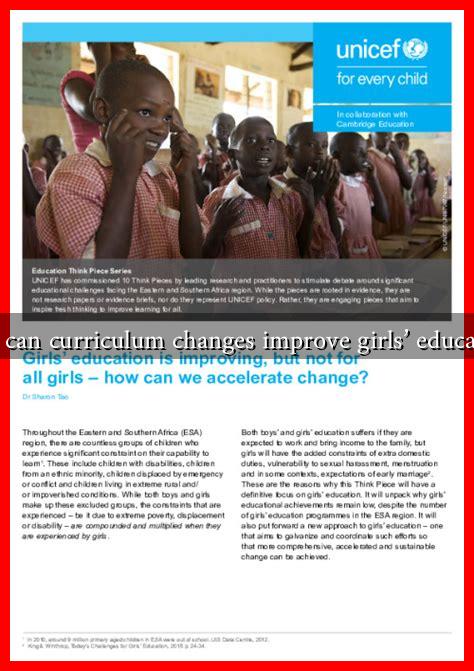-
Table of Contents
- How Can Curriculum Changes Improve Girls’ Education?
- The Importance of Gender-Sensitive Curriculum
- Case Studies: Successful Curriculum Changes
- 1. Rwanda’s Gender-Responsive Curriculum
- 2. The United Kingdom’s National Curriculum Review
- Key Components of an Effective Curriculum Change
- Statistics Highlighting the Need for Change
- Conclusion: A Path Forward
How Can Curriculum Changes Improve Girls’ Education?
Education is a fundamental right and a powerful tool for empowerment, particularly for girls. However, despite significant progress in recent years, girls around the world still face numerous barriers to education. One of the most effective ways to address these challenges is through curriculum changes that are tailored to meet the unique needs of girls. This article explores how modifying educational curricula can enhance girls’ educational experiences and outcomes.
The Importance of Gender-Sensitive Curriculum
A gender-sensitive curriculum recognizes and addresses the different experiences, needs, and challenges faced by girls in the educational system. By incorporating gender perspectives into the curriculum, educators can create a more inclusive environment that promotes equality and encourages girls to participate fully in their education.
- Increased Engagement: A curriculum that reflects the interests and experiences of girls can lead to higher levels of engagement and motivation.
- Reduction of Stereotypes: By challenging traditional gender roles and stereotypes, a gender-sensitive curriculum can empower girls to pursue subjects and careers that have been historically male-dominated.
- Improved Academic Performance: Studies have shown that when girls see themselves represented in the curriculum, their academic performance improves significantly.
Case Studies: Successful Curriculum Changes
Several countries have implemented successful curriculum changes that have positively impacted girls’ education. Here are a few notable examples:
1. Rwanda’s Gender-Responsive Curriculum
Rwanda has made significant strides in promoting gender equality in education since the 1994 genocide. The government introduced a gender-responsive curriculum that emphasizes equal participation of boys and girls in all subjects. As a result, the enrollment of girls in primary and secondary schools has increased dramatically, with girls now outperforming boys in national exams.
2. The United Kingdom’s National Curriculum Review
The UK has also made efforts to address gender disparities in education through its National Curriculum Review. By incorporating more diverse role models and examples of women in various fields, the curriculum aims to inspire girls to pursue STEM (Science, Technology, Engineering, and Mathematics) subjects. This initiative has led to a notable increase in female students enrolling in STEM courses at the university level.
Key Components of an Effective Curriculum Change
To effectively improve girls’ education through curriculum changes, several key components should be considered:
- Inclusive Content: Ensure that the curriculum includes diverse perspectives and contributions from women across various fields.
- Skill Development: Focus on developing critical thinking, problem-solving, and leadership skills that empower girls to take charge of their education and future.
- Safe Learning Environment: Create a safe and supportive learning environment where girls feel comfortable expressing themselves and participating in discussions.
- Community Involvement: Engage parents and community members in the educational process to foster a supportive atmosphere for girls’ education.
Statistics Highlighting the Need for Change
Statistics underscore the urgent need for curriculum changes to improve girls’ education:
- According to UNESCO, 130 million girls worldwide are out of school.
- Girls are 1.5 times more likely to be out of school than boys in low-income countries.
- Research indicates that educating girls can lead to a 10-20% increase in a country’s GDP.
Conclusion: A Path Forward
Curriculum changes are a vital step toward improving girls’ education globally. By adopting a gender-sensitive approach that includes diverse perspectives, promotes skill development, and fosters a supportive learning environment, we can empower girls to achieve their full potential. The examples from Rwanda and the UK demonstrate that with the right changes, we can create an educational landscape where girls thrive. As we move forward, it is essential for policymakers, educators, and communities to collaborate in implementing these changes, ensuring that every girl has the opportunity to learn, grow, and succeed.
For more information on gender equality in education, visit UNESCO’s Gender Equality in Education.


